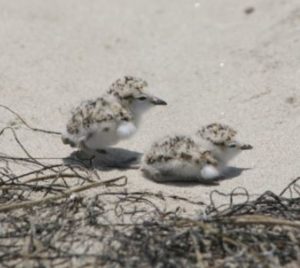(By Kim Ryan) Biologists from FWC’s Southwest Regional office, Becky Schneider (Conservation Biologist) and Tyson Dallas (Shorebird Biologist) gave a presentation on Beach Nesting Birds on Fort Myers Beach to the Marine Resources Task Force this week.
The report focused on the state’s threatened species: The Snowy Plover, Black Skimmer and Least Tern, that nest in the area from mid February through early September.
Schneider and Dallas discussed the lack of long open beach areas available for the birds to nest due to coastal development and recreational activities. According to the biologists the temporary refuge located at the south end of the island on Carlos Beach is home to “the largest seabird colony in Southwest Florida.” They said this is the biggest stronghold of Black Skimmers on a natural beach pretty much anywhere on the Gulf Coast of Florida, adding there is no alternative nesting area for this colony.
This collaboration between FWC and the private property owners requires the property owners to hand over managerial responsibility to FWC for the duration of the nesting period and then FWC will return it the way they found it. The large open sandy area which is so desirable to these birds was created over time by accreting sand and raking practices. In order to maintain that strategic vegetation, management is needed. This includes chemical and mechanical methods.
A variety of vegetation management methods were discussed including herbicides. Schneider acknowledged receipt of the letter to not use glyphosate on the beach. Vinegar, salt and Imazapyr were also debated.
According to the FWC representatives, vinegar/salt can not be used as a herbicide due to State and Federal regulation because they don’t have an EPA label. They remarked that Imazapyr “which targets a metabolic pathway involved in photosynthesis so it never emerges,” reportedly has zero effect on animals, has a lower toxicity rating compared to other similar herbicides, and will not wash away.
Schnieder also mentioned the upcoming beach nesting bird guidelines some of which will impact beach residents. For example, beach cleaning, which pertains to those who rake the beach. You can check out the draft guidelines on FWC website at
https://myfwc.com/media/28019/revised-ibnb-guidelines.pdf
They also put out a call for residents who’d like to become qualified bird monitors. These monitors will be present when a disturbance occurs, for example, in the case of a new permitted project. The bird monitor may, for example, walk in front of a tractor to look out for nests and birds if present. You can find out about the qualifications at https://myfwc.com/conservation/you-conserve/wildlife/shorebirds/bird-monitor/


Comments are closed.